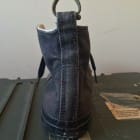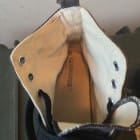Last September, social media was ablaze with multiple versions of a common theme, “Fireclean lubricant is Crisco”. The source of this buzz was an article on Vuurwapen blog by Andrew Tuohy, entitled “INFRARED SPECTROSCOPY OF FIRECLEAN AND CRISCO OILS” where he claimed to have had samples of Fireclean tested in order to determine if it was Crisco. At the time of the article, I was publicly critical of Tuohy’s methodology, relying on anonymous sources for lab tests.

The content was so popular it even spawned a second round of articles by Tuohy as well as blogger Everett Baker who claims to have conducted testing of his own that verified Tuohy’s assertions. To double down, Tuohy wrote an article where he claimed that a demonstration video of Fireclean by tactical trainer Larry Vickers was fraudulent. Interestingly, Tuohy initially published this article as “WHERE THERE’S SMOKE, THERE’S LIAR” but later changed it to “SEVERE PROBLEMS WITH VICKERS TACTICAL FIRECLEAN VIDEO”.
At the time, lots of people were quite entertained by the shenanigans. But not everyone was laughing. While most have moved on from the incident, Fireclean has not. In fact, last week they filed the first, in what we understand will be series of federal lawsuits, against Andrew Tuohy and Everett Baker. Suits against others are said to follow. According to this suit, Fireclean has suffered losses of $25,000 per month in sales since the round of articles. Seeing how they are in Northern Virginia, Fireclean has turned to Federal Court for the Eastern District of Virginia, the original ‘Rocket Docket’, for relief. Andrew Tuohy hails from Arizona and Everett Baker is from New Hampshire, according to his blog but Fireclean makes their case early on in the suit for a Virginia venue.
At the heart of this issue is whether the bloggers’ posts are protected by the First Amendment or if their actions were intentionally misleading. Fireclean alleges multiple counts of defamation against Tuohy and a single count against Baker as well as violation of the Virginia Business Conspiracy Act and Common Law Conspiracy. They are demanding a jury trial and compensatory damages, presumed damages for defamation, punitive damages in addition to court costs and attorney’s fees.
You can read the entire, 209 page suit here: Fireclean LLC v Tuohy and Baker. It’s quite extensive and in the document you can see that Fireclean does exactly what Tuohy and Baker didn’t, which was use a well known laboratory to analyze the product. Rather than rely on anonymous testing or tests performed by a college student, Fireclean obtained the services of Petro-Lubricant Testing Laboratories. Their testing is part of the suit, in exhibit R.
Whichever way this suit goes, it is one to watch because it is not only an attempt to hold firearms bloggers responsible for their content, but that it could have far reaching effects for blogging writ large as well as other social media content.
In closing, I would like to disclose that Vickers Tactical, who is not a party to this suit, but is mentioned, is an advertiser on SSD. While, Larry Vickers has endorsed Fireclean in the past, Fireclean is in no way associated with SSD.
































































































































